As baby boomers continue into their retirement transition, two portfolio-based strategies are increasingly popular to generate retirement income: the systematic withdrawal strategy, and the bucket strategy. While the former is still the most common approach, the latter has become increasingly popular lately, viewed in part as a strategy to help work around difficult and volatile market environments. Yet while the two strategies approach portfolio construction very differently, the reality is that bucket strategies actually produce asset allocations almost exactly the same as systematic withdrawal strategies; their often-purported differences amount to little more than a mirage! Nonetheless, bucket strategies might actually still be a superior strategy, not because of the differences in portfolio construction, but due to the ways that the client psychologically connects with and understands the strategy!Read More...
Under classic Modern Portfolio Theory, there is a single portfolio that is considered to have the most efficient risk/return balance for a given target return or target risk level; any portfolio which deviates from the "optimal" allocation must, by definition, either offer lower returns for a comparable level of risk, or result in higher risk for the same level of return. Accordingly, as the theory is extended, advisors should avoid making portfolio shifts that constitute tactical "bets" in particular stocks, sectors, asset classes, etc., as it must by definition result in a portfolio that is not on the efficient frontier; one that will be accepting a lower return for a given level of risk, or higher risk for a comparable return. Unfortunately, though, this perspective on MPT with respect to making tactical portfolio shifts is not accurate, for one simple reason: it is based on an invalid assumption that there is a single answer for the "right" return, volatility, and correlation assumptions that will never change over time, even though Markowitz himself didn't think that was a good way to apply his theory!
Historically, estate planning centered on tangible documentation – wills, account access, and critical information stored in safes or files, with clear instructions for heirs. However, as assets and personal information have become increasingly digitized and moved online, ensuring smooth access to digital accounts has become increasingly complicated. Digital assets range from email accounts and social media to online banking and cryptocurrency – essential elements of daily life that are often trapped behind passwords and authentication barriers. As a result, integrating digital assets into estate plans has become a crucial part of an advisor's process.
Digital assets encompass a wide range of online accounts and property, from financial holdings to sentimental items like photographs and digital media libraries. While cryptocurrency is the most well-known example, even loyalty rewards and social media accounts hold personal and financial value. Yet, contrary to popular belief, providing heirs with usernames and passwords – while crucial – may not be enough.
Because platform privacy policies often dictate how digital assets are handled after a person's passing, unauthorized access can create serious legal and security concerns, including identity theft and privacy law violations. Unlike traditional assets, which are governed by established inheritance laws that dictate how they are handled after a person dies or becomes incapacitated, digital assets often fall under individual service providers' terms of service. Given these risks, it's essential that estate plans include clear, legally recognized instructions for accessing digital assets.
Advisors can help clients navigate this process with a blend of strategic conversations and technology. First, they can help clients create a comprehensive inventory of digital assets, from banking and email accounts to cloud storage and loyalty programs. Next, ensuring that provisions about digital assets are added to the will or trust are key – especially as regulations may allow wills and trusts to supersede a platform's ac–cess restrictions. Once digital provisions are in place, advisors can help clients store this information securely in a digital vault, making it easily accessible to heirs. Finally, maintaining – and periodically reviewing – an up-to-date estate plan that provides for digital assets ensures continued access and security as rules, accounts, and assets evolve.
Ultimately, the key point is that digital assets are a critical but often overlooked aspect of estate planning. When digital assets are given the same attention and care as physical assets, clients and their heirs can have greater peace of mind that their digital legacies will be preserved and transferred smoothly as well!
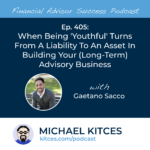
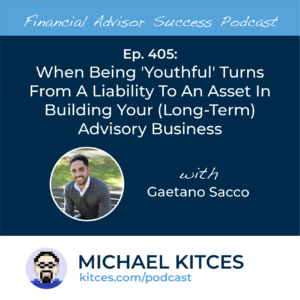 Welcome everyone! Welcome to the 405th episode of the Financial Advisor Success Podcast!
Welcome everyone! Welcome to the 405th episode of the Financial Advisor Success Podcast!
My guest on today's podcast is Gaetano Sacco. Gaetano is a partner and senior financial advisor at Fountainhead Advisors, an RIA based in Warren, New Jersey, that oversees approximately $900 million in assets under management for 1,000 client households.
What's unique about Gaetano, though, is how after breaking away from an insurance broker-dealer with barely $5M in assets under management, he has been able to quickly build his practice to $75 million in AUM in just 5 years in part by turning what was originally a liability for him in his 20s – being a 'young' advisor who prospective clients didn't always think was credible – into an asset, where Gaetano is now quickly growing his client base of retirees by highlighting how his 'youthfulness' as a 30-something means he's been around long enough to show that he's going to be a financial advisor for the long run, and still young enough that he can do this for another 30 years and actually be their financial advisor for their entire retirement (or basically, the last advisor they'll have to worry about picking in their lifetime).
In this episode, we talk in-depth about Gaetano's experience working in insurance sales starting soon after he graduated from college, including why the need to cold-call for business as a relative newcomer was both a challenge and a confidence-builder as he started to gain traction selling insurance products and some standalone financial plans, the factors that ultimately led Gaetano to decide to make the switch from insurance to the RIA channel and leave friends and mentors he had made in the insurance world despite the success he was having there after winning "Financial Planner of the Year" in his region of the company, and how Gaetano, now in his late 30s, has found his age to be an asset, as getting married and having kids has given him new perspectives in life to be able to better related to his clients and prospects, his years of experience shows that he has credible success, and his relatively young age helps him reassure his older clients that he can really be there for them in the long run.
We also talk about how Gaetano has built his current practice up to $75 million in just 5 years in part through client referrals that came after he got really proactive in addressing client concerns (from phone calls to webinars to additional written commentary and even crafting an expertise on PPP loans while they were available) during the COVID-induced market downturn, how Gaetano has since used in-person client appreciation events, including restaurant crawls and entertaining clients at a popular horse race, to both build loyalty among his current clients and to generate warm introductions to the friends that his existing clients bring to these events, and how Gaetano expanded his capable to be able to serve his 150 clients in part by empowering a newer advisor to take on plan-building and client-facing tasks while building his own book of business.
And be certain to listen to the end, where Gaetano shares how joining an advisor study group, and its structured cadence of 2 multi-day meetings every year, has guided him through multiple changes that allowed him to level up his own practice, why Gaetano turned down his first potentially lucrative job offer with an RIA because of the bad vibes he got from the firm and its leadership, and how Gaetano's realization that he wanted to work in the financial advice business for the long run influenced his decision to pursue a more planning-centric career path… that gives him the opportunity to wake up every day excited to meet with his clients (while still being able to maintain a strong work-life balance).
So, whether you're interested in learning about gaining credibility as a 'young' advisor, driving client referrals through a proactive service experience, or the professional benefits of participating in an advisor study group, then we hope you enjoy this episode of the Financial Advisor Success podcast, with Gaetano Sacco.
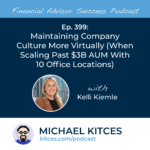
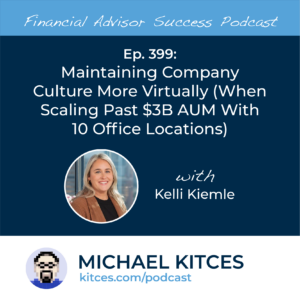 Welcome everyone! Welcome to the 399th episode of the Financial Advisor Success Podcast!
Welcome everyone! Welcome to the 399th episode of the Financial Advisor Success Podcast!
My guest on today's podcast is Kelli Kiemle. Kelli is the Managing Director of Growth and Client Experience of Halbert Hargrove, an RIA based in Long Beach, California, that oversees $3.1 billion in assets under management for 750 client households.
What's unique about Kelli, though, is how she leads efforts at Halbert Hargrove to maintain the firm's 4 core values and build a strong culture, even and especially as their team has grown to 50 employees and, with ongoing expansion, is now situated across 10 offices in the western United States (which means even their in-person offices are 'remote' and 'virtual' relative to the leadership team in the firm's main office headquarters).
In this episode, we talk in-depth about how Kelli has worked to develop programs at Halbert Hargrove to maintain communication and strong relationships across the firm and its disparate offices, including by holding twice annual in-person meetings at Halbert Hargrove's headquarters both to discuss firm business and to provide opportunities for more informal social interaction amongst the firm's otherwise-dispersed staff, how Kelli uses weekly, company-wide all-hands meetings first thing every Monday morning to review key company metrics to increase accountability, and how Kelli established a mandatory, 2-year formal mentorship program for all new hires to help them get better acclimated to the firm's culture, and to have an outlet to whom they can ask question and seek advice as they grow into their role.
We also talk about how Kelli has created initiatives that help solidify Halbert Hargrove's core values of being fearless, constantly improving, having fun, and giving back, including by having employees share not only their "Gladiator Stories" of fearlessly going to bat for their clients, but also their "Goofs That Give Us Guidance" to reflect on mistakes that were made to align to their core value of constantly improving, how Kelli has aligned her firm's employee benefits with its core values as well, including by funding educational opportunities for employees, providing a match for employee charitable donations, and offering child care subsidies, and why Kelli finds that her firm's policy of offering what it calls unlimited 'responsible' vacation time doesn't lead to employees taking too much time off, but instead ironically still requires her to encourage staff to take more time off to avoid potential burnout.
And be certain to listen to the end, where Kelli shares how she has helped increase Halbert Hargrove's AUM over the $3 billion mark in part by leveraging a public relations firm as well as local search engine optimization to attract new prospects and lift their organic growth rate, how Kelli brought on a sales coach to help her firm's existing advisors get comfortable trying to close more clients (overcoming some initial skepticism about how a fiduciary firm could ever have "sales training"), and why Kelli decided against pursuing the advisor track at her own firm, instead carving out a role focused on growth and client experience that fit her strengths in creating and managing complex firm-wide workflows and juggling many tasks at once.
So, whether you're interested in learning about maintaining a strong firm culture when offices are spread across the country, aligning company benefits to match those core values, or using third-party marketing and sales coaching firms to drive client growth, then we hope you enjoy this episode of the Financial Advisor Success podcast, with Kelli Kiemle.
Traditionally, people tend to think of their estate as comprising one big 'pot' of assets, focusing on the sum of all the assets rather than on each individual asset itself. Consequently, when in estate planning, thinking about how to divide their assets after their death, they often aim to simply apportion the whole pot among their beneficiaries, without regard to the nature of each individual asset.
Although the 'one big pot' mindset might be the simplest approach to estate distribution, it may not be the one that results in the most wealth being passed down or the most equitable distribution of assets between each beneficiary. That's because, depending on the beneficiaries' individual situations, different types of assets will have different tax characteristics when inherited, which might make particular assets better or worse for different beneficiaries depending on their tax circumstances. For instance, if a traditional IRA is split equally between 2 beneficiaries in different tax brackets (or in different states of residence with different state tax rates), the beneficiary in the higher tax bracket will pay more tax on their share of the IRA (and consequently receive less on an after-tax basis) than the other.
Consequently, it can be beneficial to approach estate planning on an asset-by-asset basis to make the process more equitable and tax efficient by accounting for the disparity of income tax treatment of the different assets in the estate (and the unequal tax circumstances of the beneficiaries who will inherit them). For instance, an estate with a mix of pre-tax retirement assets (taxed upon withdrawal by the beneficiary) and nonqualified assets (which typically receive a step-up in basis and have fewer tax consequences for the beneficiary) can be allocated such that the pre-tax assets are left to the beneficiary with a lower tax rate and the nonqualified assets to the beneficiary with a higher tax rate. Then not only will each beneficiary receive the asset that results in the highest after-tax value to them, but the total after-tax value of all the assets passed down will be higher than if they were each simply divided equally between the beneficiaries.
Notably, an asset-by-asset approach to estate planning isn't 'just' about drafting documents like wills or trusts; it requires full knowledge of the client and the details of their (and their beneficiaries') financial, tax, and overall life circumstances. Which leaves financial advisors in a unique position to aid in the process of deciding when an asset-by-asset approach will result in sizable tax savings for the estate and beneficiaries and when a traditional 'split-the-pot' approach would make more sense. As while estate attorneys may meet with the client only rarely (if at all) after the actual estate documents are drafted, advisors usually have regular recurring meetings with clients, giving advisors the opportunity to keep up with the family's dynamics and tax situations and recognize when a change would be warranted.
The key point is that, just as clients have different planning needs, goals, and tax circumstances during life, the same applies to their beneficiaries and assets after they're gone. Incorporating the impact of taxes in the financial planning process to help clients keep more of what they've earned in life makes as much sense as using the same approach in the estate planning process, by considering what happens from a tax perspective after the assets reach their intended destination. And, by offering a more equitable distribution scheme for their beneficiaries, advisors can help their clients ensure they pass the most (after-tax) wealth to the next generation!
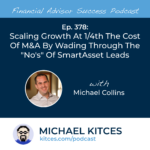
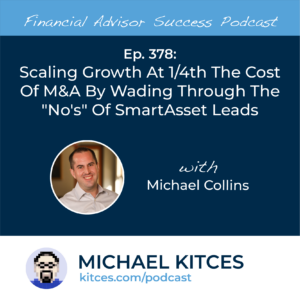 Welcome back to the 378th episode of the Financial Advisor Success Podcast!
Welcome back to the 378th episode of the Financial Advisor Success Podcast!
My guest on today's podcast is Michael Collins. Michael is the CEO & Founder of WinCap Financial, an RIA based in Boston, Massachusetts, that oversees $80M in assets under management for 70 client households.
What's unique about Michael, though, is that since 2021 he has been able to grow WinCap Financial at a rate of more than $10M of AUM per year through consistently reaching out to leads purchased through SmartAsset, spending $5K/month that turns into $10K in recurring revenue in less than 100 days, an average of more than 4X the return on financial investment than if those clients had been obtained through an acquisition buying at a traditional 2X revenue multiple.
In this episode, we talk in-depth about how Michael maintains his ongoing $5K/month marketing spend with a process that has an ultimate failure rate of 95% because the financial ROI on the prospects that do close continues to make sense (and he is ultimately not afraid of sorting through the No's to find the right Yes's for WinCap), how Michael supports his SmartAsset conversion rate with a weekly blog that is written by taking the upcoming economic calendar, automating it into a narrative article in his writing style using ChatGPT, and then simply editing it to add his own commentary (which cuts the time it takes for him to write from 2 hours down to 30 minutes), and how Michael has systematized everything from his follow-up emails to text messages to his weekly blog and an ongoing tracking sheet to ensure no prospect slips through the cracks, which allows him to generate his results with a high volume of SmartAsset leads while only spending 8–10 hours/month on the entire process.
We also talk about Michael's advisor journey that began with selling Gateway Computer "Cow Boxes" in college (and getting used to the No's that came along with computer sales) and how Michael channeled that comfort-with-hearing-No into his career shift into wealth management with a process that has a "20 leads to 3 prospects to 1 new client" marketing formula, the reason Michael's decided during the pandemic to take a chance on leaving his then-current advisory firm starting his own RIA (after realizing that he was already doing the important aspects of both client service and business development himself, which made it difficult to justify why his current firm was owed an 80% share of the revenue he was bringing in), and how, when the stress of launching his firm was at an all-time high and a concern for the sustainability of WinCap at the end of 2022 was a major challenge, Michael found that acts of service in education – by becoming a part-time adjunct professor teaching college students – became a key rewarding element of life that kept him going.
And be certain to listen to the end, where Michael shares how moving from a large, firm-supported environment to an independent practice wasn't as hard as he expected because he could easily integrate tools and platforms he was already familiar with (and had the financial ability to get a $50K bank loan to buy a big chunk of SmartAsset leads, which further helped to jump-start his new practice), how surprised Michael was with the amount of support he did get when he launched WinCap, with more than 80% of his previous client base also following him into his new firm within a year, and how Michael had long struggled to take the leap because of the perceived safety and credibility in being part of a larger advisory firm but ultimately found that he could get similar credibility by affiliating his new firm with reputable RIA custodians… which helped Michael's clients, and also Michael himself, find the necessary confidence to move forward.
So, whether you're interested in learning about how to effectively use lead generation tools like SmartAsset to grow and connect with potential clients, how to justify a shift from a large company-supported firm to an independent solo practice or how to use ChatGPT to 'Frankenstein' blog posts that communicate complicated financial information in an easier-to-understand way for your audience, then we hope you enjoy this episode of the Financial Advisor Success podcast, with Michael Collins.
Many investors are familiar with private equity as an alternative asset class, which is popular with certain high-net-worth and institutional investors as a vehicle for diversification and a source of potentially higher risk-adjusted returns than what is available on the public market. However, less well-known is the related but distinct asset class of private debt, which, like private equity, focuses on opportunities outside of what is traded on the public market but deploys its capital in the form of credit rather than taking equity stakes in companies. And in the midst of a rough market for publicly traded debt, high-net-worth individuals (and their advisors) who might be seeking alternatives for the fixed-income portions of their portfolio may be curious about what private debt might have to offer.
While public market and private equity asset classes are much more thoroughly researched, research on private debt providing reliable data on returns, volatility, fees, and other characteristics has been relatively scarce. However, a recent paper by Pascal Böni and Sophie Manigart in the Financial Analysts Journal sheds new light on how private debt has performed over time and provides insight into what factors advisors and their clients should focus on when considering private debt for their portfolios.
One of the paper’s key takeaways is that although private debt as an asset class has delivered higher risk-adjusted returns compared to traditional fixed-income investments, there is a wide range of outcomes between individual private debt funds, with a relatively small cluster of top-performing funds delivering much of the asset class’s overall outperformance. And while the maxim “past performance does not indicate future results” holds true for traditional asset classes, the reverse has proven at least somewhat true for private debt: Among private debt funds and the General Partner who manages them, prior performance was a significant indicator of future performance, with funds having a good performance history being the most likely to outperform in the future. Funds with GPs who had no history of prior private debt fund management had some of the worst performance, suggesting that not only do past returns but also the skills and experience of General Partners have much to do with which private debt funds are likely to have the best returns.
For advisors, examining the management and culture of a private debt fund can be an important way to provide value to clients through a thorough due diligence process. This can include assessing the experience and performance history of the fund’s GP and how the fund has achieved its returns (e.g., by making concentrated bets or through a more diversified approach). And while the choice of a fund may be the most significant decision regarding private debt, advisors can add value in other ways as well, such as by incorporating private debt into a client’s existing asset allocation strategy, optimizing the asset location of a private debt fund, and analyzing the fund’s fee structure.
Ultimately, what’s most important is that clients have a solid understanding of the risks involved with investing in private debt versus remaining in the public markets. Namely, the illiquidity of private funds (which can keep clients’ funds locked up for 10 years or more) makes them most appropriate for clients with a long-term investing horizon and with other liquid funds for short-term and unexpected needs. Advisors who can help their clients navigate these important considerations, and keep the client’s focus on the long term, can be an invaluable aid in ensuring those clients can realize the potential advantages that private debt can make possible!

While President Joe Biden’s recently proposed “Build Back Better” brought the possibility of a reduced estate tax exemption for 2022, insufficient support for the bill precluded the reduction, leaving taxpayers with an exemption of $12,060,000 per person. Which means that under the current rules, most taxpayers will not be subject to a Federal Estate tax liability and can instead focus their tax planning efforts on reducing their Federal income tax liability. As such, the step-up in basis at death can be a powerful planning tool for minimizing an individual’s capital gains taxes from the sale of appreciated assets. For married couples, though, the death of one spouse often only results in a partial step-up, reducing the value of this tax benefit (and thereby potentially increasing taxes on the subsequent sale of assets) for the surviving spouse. But with some proactive planning, couples can take greater advantage of the step-up rules by titling their assets in a way that maximizes their likelihood of a full step-up.
The concept of the step-up is that, when an individual dies, the basis of the assets that they owned is increased (or “stepped up”) to their value as of the date of the individual’s death. And while the concept is fairly straightforward for assets owned solely by the decedent, it can become more complicated when the assets are owned jointly with a spouse. Because in most states (which treat jointly-owned assets as “separate property”), even though the assets are owned in both spouses’ names, the amount that is included in the decedent’s estate – and therefore eligible for the step-up – is only 50% of the assets’ value, leaving the original basis intact on the surviving spouse’s remainder. Notably, ten “community property” states allow for a 100% step-up in basis on all jointly-held assets (as long as they meet the definition of community property). Which means that, based on whether or not a couple happens to live in a community property or a separate property state, they may receive a full (or just a partial) step-up in basis on their jointly-owned assets when one spouse passes away.
Fortunately, for the majority of couples who live in separate property states, there is a simple strategy that can be used to potentially receive a full step-up in basis of assets upon the death of a spouse. For couples where one spouse is expected to live longer than the other, it may be possible to transfer all of the couple’s assets solely into the name of the spouse anticipated to die first. Upon that spouse’s death, 100% of those assets would be subsequently included in their estate and therefore subject to a full step-up when the surviving beneficiary spouse receives the assets.
As with many seemingly simple strategies, however, the transfer-and-inherit strategy between spouses comes with complications and exceptions to watch out for. For example, the IRS requires that the spouse who receives the transfer of assets must own them for at least one year before they pass back to the original donor in order to receive the step-up in basis, making the strategy less useful when the spouse’s death is anticipated more imminently. Additionally, gifting assets means giving up control over how they are used and bequeathed, and so the strategy requires the surviving spouse to trust that the shorter-lived spouse will not spend the assets, give them away, or leave them to someone other than the surviving spouse at death (however unlikely that may seem at the time). And lastly, if a spouse is enrolled in Medicaid (or plans to enroll in the future), transferring assets into their name could exceed the allowable asset limit set for Medicaid eligibility, thereby disqualifying them from the program and requiring them to spend down the assets to re-enroll (making the strategy a moot point, as the assets would likely not last long enough to be stepped up at all!).
Ultimately, the difference between a full step-up in basis and a partial one (or none at all) can end out being a significant increase in the after-tax value of assets for some clients. Advisors can help deliver this value to their clients by planning and aiding with the retitling of assets (when appropriate) to take full advantage of the basis step-up. Which is important, especially because the subject of death (and repositioning assets in anticipation of death) may be complex and emotional for clients, and the role of the financial advisor often involves aiding clients to find objective solutions through difficult situations… to help clients – and their loved ones – stay on track with their goals to maximize and enjoy their wealth!Read More...
According to the latest 2021 Genworth Cost of Care study, a private room in a nursing home costs almost $300/day, or nearly $9,000 per month. Fortunately, individuals in need of such institutional health care, who don’t have the means to pay for such care themselves, can generally rely on Medicaid to cover at least most of those long-term institutional care costs. However, as a means-tested program operated as a Federal-state partnership, Medicaid places extremely low limits not just on an individual’s income, but also on their “Countable Assets” that they are entitled to keep before they can qualify for coverage. Accordingly, those who will eventually rely on Medicaid to cover their cost of care must ‘spend down’ their own income and assets first… which can have a significant impact on the individual’s (and their families’) standard of living. Which raises the question of what planning can be done to help protect at least the other members of the family in situations where a Medicaid spend-down must occur.
While the limits on Countable Assets (including most of an individual’s assets such as cash, investments, bank accounts, and real estate) vary by state, the most commonly observed is a mere $2,000 in 2021. However, to allow a healthy spouse (with an ill partner applying for Medicaid) to maintain at least a minimal level of the couple’s assets and income to live on, the Medicaid rules include standards that set the amount of income and assets that can be maintained from the couple’s assets (and the institutionalized individual’s income) to maintain the healthy spouse’s standard of living without an obligation to spend them down for the ill spouse’s care.
To prevent couples from simply trying to ‘impoverish’ themselves to qualify for Medicaid, though, Medicaid rules include a five-year “Look-Back Period” (2½ years for California), which prevents recipients from simply giving away assets to (non-spouse) family members to meet Medicaid’s asset limits. Notably, though, when it comes to spousal income, the treatment is different, with the healthy spouse’s income generally being left out of the eligibility calculation altogether.
As a result, one strategy for married couples to preserve assets in light of the Look-Back Period for asset transfers, but the exclusion of the healthy spouse’s income, is to purchase a “Medicaid Annuity”. Essentially, assets in excess of the Countable Asset limit are used to purchase a Medicaid Annuity (such that the couple’s assets are within their allowed Countable Asset limit); then, annuity payments are made payable only to the healthy spouse. In doing so, the Countable Assets that would have otherwise been required to have been spent down to pay for the care of the institutionalized spouse are removed – but not as a gift, avoiding a look-back penalty period – and instead become income of the healthy spouse (which are effectively ignored for purposes of Medicaid eligibility).
Notably, though, not all states currently permit the use of Medicaid Annuities. And in states that do, to be Medicaid-compliant, the Medicaid Annuity must name the State (in those states that permit their use) as the remainder beneficiary for no less than the amount of Medicaid benefits it paid on behalf of the institutionalized individual. Which doesn’t limit the healthy spouse’s ability to leverage the Medicaid annuity for their own standard of living… but does mean that at least if both spouses do not survive the Medicaid annuity payout period, the State can recover Medicaid benefits it paid before those assets are bequeathed to subsequent heirs.
Ultimately, the key point is that for seniors or chronically disabled individuals who may need Medicaid benefits for their long-term care but fear the impact that spending down assets will have on their healthy spouse’s own standard of living, the Medicaid Annuity is a useful tool (at least in the states that permit them) to help the couple preserve assets by converting them into an annuity income stream. Which can be a valuable option to consider, especially in light of the last-minute ‘crisis’ nature that is often characteristic of Medicaid planning, when it’s too late to simply gift assets to family members by the time it’s necessary!


